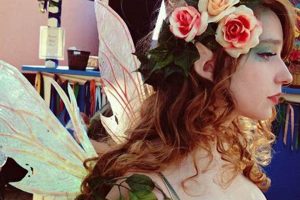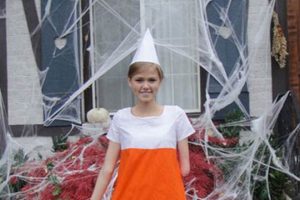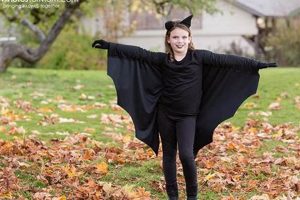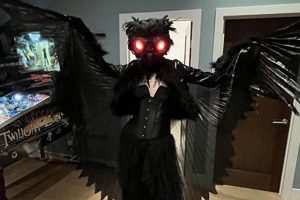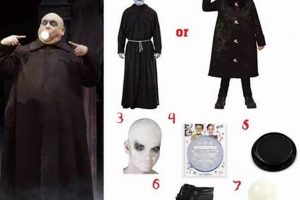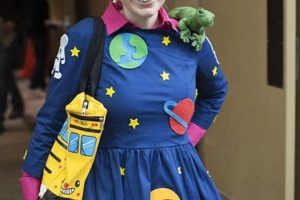Creating a homemade undead bride ensemble allows individuals to embody the iconic character through personalized artistry. Such projects often involve repurposing existing garments, applying theatrical makeup techniques, and crafting signature accessories, resulting in a unique visual representation. For instance, a tattered wedding dress, pale foundation, and blue-tinged hair spray can be combined to evoke the character’s spectral appearance.
Undertaking this kind of creative endeavor fosters resourcefulness and provides a cost-effective alternative to purchasing pre-made costumes. Furthermore, the process allows for individual interpretation and the expression of personal artistic vision, resulting in a more authentic and impactful portrayal. Historically, the practice of constructing one’s own attire for festive occasions has been a common method of celebration, emphasizing individuality and skill.
The subsequent sections will detail specific techniques for achieving a convincing deceased bride aesthetic, covering garment alterations, makeup application, and accessory creation. Detailed guides will be provided for those seeking to meticulously recreate the look, or for those who prefer a more abstract, interpretive approach.
Tips for a Successful Corpse Bride Costume
Achieving a compelling spectral bride appearance necessitates careful attention to detail and skillful execution of various techniques. The following guidance offers crucial recommendations for effective costume construction.
Tip 1: Select a Durable Base Garment: Begin with a pre-owned wedding dress or a suitable approximation. A robust fabric allows for controlled distressing without excessive tearing or disintegration. Evaluate thrift stores or online marketplaces for affordable options.
Tip 2: Prioritize Controlled Fabric Degradation: Employ strategic ripping, fraying, and staining techniques. Avoid haphazard destruction; plan the placement of tears and emphasize wear and tear around seams and edges. Consider using sandpaper or seam rippers for controlled degradation.
Tip 3: Master Pale Makeup Application: Achieve a convincingly deceased complexion through careful layering. Start with a white or pale foundation, then subtly contour with shades of gray and blue. Utilize setting powder to ensure longevity.
Tip 4: Emphasize Undereye Discoloration: Replicate the characteristic sunken eye appearance using dark eyeshadows in shades of purple, blue, and gray. Blend meticulously to avoid harsh lines, creating a realistic depiction of fatigue and decay.
Tip 5: Craft a Believable Hairstyle: Construct a disheveled, yet elegant hairstyle. Loose braids, scattered floral accents, and strategically placed cobwebs enhance the overall aesthetic. Consider a wig if natural hair does not readily accommodate the desired style.
Tip 6: Incorporate Signature Blue Tones: Introduce subtle hints of blue into the makeup, hair, and potentially even the dress. This hue is integral to the character’s visual identity and contributes significantly to the overall effect.
Tip 7: Accessorize Thoughtfully: Select accessories that complement the overall design. A withered bouquet, a tattered veil, and strategically placed faux bones can elevate the costume’s impact. Ensure accessories appear aged and deteriorated to align with the character’s condition.
By adhering to these guidelines, costume creators can effectively capture the character’s essence, resulting in a hauntingly beautiful and memorable portrayal.
With these tips in mind, preparation can begin on key elements of the desired deceased bride appearance.
1. Repurposed wedding dress
The connection between a repurposed wedding dress and this style of DIY costuming lies in the garment’s inherent symbolic value and visual impact. A wedding dress, traditionally representing purity and celebration, undergoes a transformative deconstruction to embody a character defined by death and decay. This juxtaposition is central to the costume’s thematic effectiveness. The use of a pre-owned wedding dress, rather than newly purchased fabric, contributes to the costume’s authenticity. The existing fabric may already possess subtle imperfections or age-related wear, adding to the desired distressed appearance. For example, vintage dresses acquired from thrift stores often present with a faded or yellowed hue, which can be further enhanced with staining techniques.
The act of repurposing the dress also offers practical benefits. It reduces the overall cost of the project, as used dresses are typically far more affordable than new materials. The existing construction of the dress, including seams, embellishments, and structural support, provides a solid foundation for alterations and modifications. A dress with existing lace, beading, or embroidery can be strategically distressed and incorporated into the decayed aesthetic, saving time and effort compared to adding these details from scratch. This foundation facilitates techniques like controlled tearing, dyeing, and the addition of skeletal embellishments. Furthermore, finding a dress that is close to the correct size and shape to begin with can dramatically simplify the crafting process.
In summary, the repurposed wedding dress serves as a foundational element for a successful deceased bride portrayal. It is a symbolic object that allows for the direct visual representation of the theme. The use of a pre-owned dress offers cost-effective benefits and leverages existing fabric characteristics to enhance the authenticity and impact of the costume. The potential challenges include finding a dress that fits both the wearer and the desired aesthetic and employing appropriate techniques to transform the garment without completely compromising its structural integrity.
2. Theatrical makeup application
Theatrical makeup application serves as a crucial component in achieving a convincing Corpse Bride aesthetic. It transcends everyday cosmetic practices, demanding specific techniques and products to emulate the character’s spectral appearance.
- Foundation and Complexion Alteration
Achieving the signature pallid complexion necessitates the application of white or near-white foundation. This establishes a base, effectively removing natural skin tones and creating a canvas for subsequent contouring. This foundation should be applied evenly, extending beyond the face to the neck and dcolletage to avoid visible lines of demarcation. Setting powders are essential to minimize shine and ensure longevity, particularly under stage or photography lighting. In the context of portraying a decaying character, precision in application is paramount to conveying the intended visual narrative.
- Contouring and Shadowing Techniques
Subtle contourin
g with shades of gray, blue, and purple is vital to sculpting the face and emphasizing sunken features. These shades should be applied to the hollows of the cheeks, temples, and eye sockets to create the illusion of depth and bone structure. Blending is crucial to avoid harsh lines, which detract from the character’s ethereal quality. Referencing professional stage makeup guides or tutorials is advisable to master these techniques. The strategic use of shadow and light enhances the overall spectral appearance. - Eye Makeup and Undereye Discoloration
Replicating the character’s distinctive large eyes and dark undereye circles requires careful product selection and application. Black or dark brown eyeliner is used to define the eyes, often extending beyond the natural lash line to exaggerate their size. Dark eyeshadows, typically in shades of purple, blue, and gray, are blended beneath the eyes to simulate discoloration and fatigue. The intensity of the undereye circles should be proportional to the overall makeup aesthetic. Overly dramatic or poorly blended eye makeup can appear cartoonish, undermining the costume’s realism.
- Lip Color and Mouth Distortion
The deceased bride character typically features pale or muted lip color, often achieved with gray or lavender lipstick shades. The goal is to de-emphasize the lips, furthering the illusion of death and decay. Some interpretations involve slight distortions of the mouth shape, accomplished with makeup or prosthetics. This could include creating subtle cracks or crevices around the lips to suggest dehydration or decomposition. However, these techniques should be used sparingly to avoid compromising the wearer’s ability to speak or express emotions.
The effective use of theatrical makeup application techniques substantially elevates the authenticity of a deceased bride portrayal. Mastering these skills allows for the creation of a compelling visual transformation, contributing significantly to the costume’s overall impact and thematic resonance. When executed with precision, these methods bring the character to life, creating a memorable and captivating visual experience.
3. Distressed fabric techniques
Distressed fabric techniques are integral to achieving the desired aesthetic in a deceased bride costume creation. The visual impact of the costume relies heavily on the illusion of age, decay, and wear. Therefore, the application of controlled damage and alterations to the fabric is not merely decorative; it is fundamental to conveying the character’s narrative and backstory. Without convincing distressed fabric, the costume risks appearing artificial or incomplete.
Several techniques contribute to this effect. These include strategic tearing, fraying, and the application of stains. Tearing is often employed to create jagged edges and expose underlying layers of fabric, simulating damage incurred over time. Fraying, achieved through controlled unraveling of the fabric’s weave, adds texture and reinforces the impression of deterioration. Staining, using diluted paints, dyes, or even coffee grounds, introduces discoloration and simulates the effects of exposure to the elements or burial. For example, sandpaper can effectively distress edges and seams, while diluted brown and grey paint can create realistic-looking stains. The careful combination of these techniques allows for nuanced control over the final appearance, ensuring the costume reflects the intended level of decay.
Mastering these techniques is crucial for a successful costume. The challenge lies in achieving a balance between creating a convincingly aged garment and avoiding irreparable damage that compromises the costume’s structural integrity. Understanding the properties of different fabrics and their response to various distressing methods is also essential. Ultimately, the skillful application of distressed fabric techniques transforms a simple garment into a compelling visual representation of a character’s history and condition, enhancing the overall impact of the costume.
4. Signature blue undertones
The incorporation of distinct blue undertones constitutes a hallmark of the spectral bride aesthetic, inextricably linked to the character’s visual identity and the overall success of associated costume endeavors. This element transcends mere color choice, functioning as a symbolic marker of death, decay, and otherworldly existence.
- Symbolic Representation of Decay
Blue, often associated with coldness and lifelessness, effectively signifies the absence of vitality. In the context of this costume, the strategic application of blue undertones to the skin, hair, and even the dress fabric visually communicates the character’s deceased state. This technique draws upon established color psychology to elicit a subconscious association with mortality and the supernatural.
- Enhancement of Ethereal Appearance
Blue undertones contribute to an ethereal, almost translucent quality, enhancing the character’s otherworldly appearance. The subtle infusion of blue hues into the complexion creates a contrast with traditional notions of human vibrancy, lending the character a ghostly, spectral presence. This element is particularly effective under stage or photography lighting, where the blue tones can be further accentuated.
- Integration Across Costume Elements
The application of blue undertones is not confined solely to makeup; rather, it should be integrated across various costume components. This includes incorporating blue tints into the hair, whether through temporary sprays, wigs, or subtle dyeing techniques. Furthermore, the dress itself may feature delicate blue accents, either through dyed fabric, painted embellishments, or the strategic placement of blue accessories. This cohesive integration reinforces the overall thematic unity of the costume.
- Depth and Dimension in Makeup Application
The use of blue tones in makeup applications extends beyond a simple base layer. Skilled makeup artistry involves layering different shades of blue, purple, and gray to create depth and dimension in the complexion. This approach simulates the complex discoloration associated with decay, enhancing the realism and visual impact of the costume. Careful blending is essential to avoid a cartoonish or artificial appearance.
These facets underscore the indispensable role of signature blue undertones in achieving a credible and visually compelling spectral bride portrayal. The strategic integration of this color element across all aspects of the costume, from makeup to fabric and accessories, is pivotal to embodying the character’s essence and creating a lasting visual impression.
5. Character-accurate accessories
The meticulous selection and crafting of character-accurate accessories are critical to the success of a homemade spectral bride ensemble. These details enhance the overall visual narrative and solidify the wearer’s embodiment of the iconic character. Their absence diminishes the impact of the costume.
- Withered Bouquet
A bouquet of dead or decaying flowers serves as a visual representation of lost life and fading beauty. It is created using dried or artificial flowers, often painted in muted tones of gray, blue, and purple. The arrangement should appear fragile and incomplete, with drooping stems and scattered petals. The withered bouquet symbolizes the bride’s untimely demise and unfulfilled vows.
- Tattered Veil
The veil, a traditional symbol of purity and innocence, is repurposed to reflect the character’s tragic circumstances. It features tears, rips, and stains, signifying the disruption of marital vows and the bride’s descent into the afterlife. The fabric should be delicate and translucent, enhancing the ethereal appearance. Its damaged state contrasts sharply with its original symbolic meaning.
- Skeletal Embellishments
The inclusion of subtle skeletal details underscores the character’s state of decay. This may involve incorporating small, faux bone fragments into the dress, hair, or makeup. The use of skeletal motifs reinforces the theme of mortality and emphasizes the bride’s transformation from living to deceased. These elements should be integrated tastefully to avoid a grotesque or comical effect.
- Rusted Jewelry
Jewelry, such as a tarnished wedding ring or a decaying necklace, adds a layer of historical context and personal tragedy. The rusted or tarnished appearance indicates the passage of time and the neglect of once-cherished possessions. The jewelry serves as a poignant reminder of the bride’s past life and the irreversible loss she has experienced. A careful balance between elegant design and visible deterioration is essential.
These character-accurate accessories collectively contribute to a comprehensive and believable portrayal of the spectral bride. Their individual symbolic value and cohesive integration enhance the overall impact of the costume. Their inclusion signifies a dedication to detail and amplifies the narrative potential of the costume, creating a poignant and memorable representation of the character.
6. Wig styling proficiency
Wig styling proficiency is a crucial aspect of crafting a compelling homemade spectral bride costume. The hairstyle significantly contributes to the character’s visual identity and overall aesthetic impact. Without adequate skill in wig manipulation, the final costume may lack authenticity and visual appeal.
- Achieving the Signature Disheveled Look
Replicating the character’s iconic, partially unkempt hairstyle necessitates proficiency in creating a deliberately imperfect appearance. This involves techniques such as teasing, backcombing, and strategically arranging strands to simulate decay and neglect. Real-world examples include professional hairstylists employing similar methods to create “undone” or “deconstructed” hairstyles for editorial or runway presentations. In the context of constructing a deceased bride ensemble, mastering these skills is vital for conveying the desired impression of supernatural disarray.
- Color Adaptation and Integration
Adapting the wig’s color to match the character’s signature blue-tinged or pale aesthetic demands skill in dyeing or tinting synthetic fibers. Uneven application or improper color selection can result in an artificial or unconvincing appearance. Historical examples from theatrical costuming and special effects makeup demonstrate the importance of precise color matching and blending for creating believable character portrayals. For a DIY spectral bride, expertise in color modification is essential for achieving a visually cohesive and authentic look.
- Floral and Accessory Integration
Incorporating floral accents, such as dried or artificial flowers, and other accessories into the wig requires proficiency in securing these elements without compromising the wig’s structure or aesthetic. Improperly attached accessories can appear clumsy or detract from the overall design. Examples from professional cosplay and theatrical wig design showcase the art of seamlessly integrating embellishments for a visually stunning effect. In the context of this kind of costuming, mastering accessory integration enhances the character’s visual narrative and adds depth to the costume.
- Wig Maintenance and Longevity
Maintaining the wig’s condition and extending its lifespan requires knowledge of proper cleaning, storage, and repair techniques. Neglecting these aspects can lead to tangling, matting, or irreversible damage. Examples from the world of professional wig styling underscore the importance of preventative maintenance for ensuring long-term wearability. When creating a homemade spectral bride costume, the ability to care for and preserve the wig is crucial for maximizing its value and extending the costume’s lifespan.
These facets of wig styling proficiency directly influence the quality and impact of a spectral bride costume. Skillful wig manipulation contributes to a convincing and visually compelling portrayal, enhancing the character’s presence and overall narrative effect. While purchasing a pre-styled wig may seem convenient, the ability to customize and maintain a wig is essential for achieving a truly unique and authentic representation.
7. Budget-conscious material sourcing
The creation of a convincing spectral bride costume frequently necessitates adherence to budgetary constraints. Strategic material acquisition is paramount to realizing the desired aesthetic without incurring excessive expense.
- Thrift Store Utilization
Thrift stores serve as primary resources for acquiring pre-owned wedding dresses and related garments at reduced prices. These establishments offer a diverse selection of styles and fabrics, enabling costume creators to locate suitable base materials without exceeding predetermined financial limitations. Moreover, thrift stores provide opportunities to repurpose existing textiles, aligning with sustainable practices and minimizing environmental impact. For example, a damaged or outdated dress can be transformed into a character-accurate costume through strategic alterations and distressing techniques.
- Discount Fabric Retailers
Discount fabric retailers provide access to affordable materials for embellishments, alterations, and accessory construction. These outlets often feature remnants, discontinued fabrics, and surplus stock at significantly reduced prices compared to conventional fabric stores. Costume creators can leverage these discounts to procure materials such as lace, tulle, and trim for adding intricate details to the spectral bride ensemble. Strategic sourcing from discount retailers maximizes resource allocation and promotes cost-effectiveness.
- Repurposing Existing Materials
The repurposing of existing materials constitutes a fundamental aspect of budget-conscious costuming. Garments, textiles, and accessories found within one’s own household can be creatively transformed to fulfill specific design requirements. For instance, old curtains or linens can be dyed and distressed to create a tattered veil, while discarded jewelry can be repurposed as decaying embellishmen
ts. This approach minimizes material costs, promotes resourcefulness, and reduces reliance on external purchases. - Online Marketplaces and Community Resources
Online marketplaces and community resources offer avenues for acquiring materials at competitive prices or even obtaining them for free. Platforms such as Craigslist, Freecycle, and local community groups facilitate the exchange of unwanted items, including clothing, fabrics, and accessories. Costume creators can leverage these resources to acquire materials without incurring any financial expenditure, thereby maximizing budget efficiency. Moreover, engaging with online communities provides opportunities to collaborate with other costume enthusiasts and share resources.
Strategic implementation of budget-conscious material sourcing techniques enhances the feasibility of creating a high-quality spectral bride costume within defined financial parameters. Prioritizing thrift store utilization, discount fabric retailers, repurposing, and community resources promotes cost-effectiveness, resourcefulness, and sustainability in costume construction.
Frequently Asked Questions
The following addresses frequently encountered inquiries regarding the construction of a homemade spectral bride costume. These questions aim to provide clarity on common challenges and misconceptions associated with such projects.
Question 1: What is the optimal approach to achieving the character’s signature pale complexion using readily available makeup products?
Achieving the desired pallor necessitates the application of a white or near-white foundation. This base should be evenly distributed across the face, neck, and dcolletage. Contour with subtle shades of gray and blue to simulate depth and shadow. Setting powder is crucial to prevent shine and ensure longevity.
Question 2: How can a convincing “tattered” effect be created on a pre-owned wedding dress without compromising its structural integrity?
Controlled fabric degradation is paramount. Employ strategic ripping, fraying, and staining techniques. Avoid haphazard destruction; plan the placement of tears and emphasize wear and tear around seams and edges. Tools such as sandpaper and seam rippers facilitate controlled degradation.
Question 3: What are the recommended methods for incorporating the character’s signature blue undertones into the makeup application?
Blue undertones can be integrated through the use of blue-tinted foundation, eyeshadow, and lip color. Apply these elements subtly to avoid an artificial appearance. Layering different shades of blue, purple, and gray enhances depth and dimension.
Question 4: What are some affordable alternatives to purchasing a professional-grade wig for achieving the character’s hairstyle?
A budget-conscious alternative involves styling a pre-owned or inexpensive wig. Techniques such as teasing, backcombing, and strategic placement of accessories can create a convincing disheveled appearance. Hair spray and temporary hair color sprays can further enhance the desired aesthetic.
Question 5: How can character-accurate accessories, such as a withered bouquet and tattered veil, be created using readily available materials?
A withered bouquet can be constructed using dried or artificial flowers, painted in muted tones. A tattered veil can be created by strategically ripping and staining a piece of tulle or lace fabric. Repurposing existing materials minimizes costs and promotes resourcefulness.
Question 6: What are some effective strategies for preventing makeup smudging or fading during extended wear, particularly in environments with high humidity?
Setting spray is essential for locking in makeup and preventing smudging or fading. Apply setting spray liberally after completing the makeup application. Additionally, blotting papers can be used to absorb excess oil and moisture throughout the day or evening.
The information provided addresses common concerns and offers practical guidance for successfully constructing a spectral bride costume. Adherence to these recommendations will enhance the overall quality and impact of the final product.
The subsequent section will address advanced techniques for those seeking a more elaborate creation.
corpse bride costume diy
This exposition has detailed various techniques and considerations pertinent to effective execution of a deceased bride ensemble. From the nuanced application of theatrical makeup to the strategic degradation of fabric and the thoughtful integration of character-accurate accessories, each element contributes to a successful embodiment of the spectral figure. Furthermore, emphasis has been placed on budget-conscious material sourcing and the importance of wig styling proficiency.
The pursuit of an impactful visual representation demands meticulous attention to detail and a thorough understanding of the character’s aesthetic hallmarks. Whether seeking a faithful recreation or a more interpretive approach, the principles outlined herein provide a foundation for achieving a hauntingly memorable and artistically compelling portrayal.


